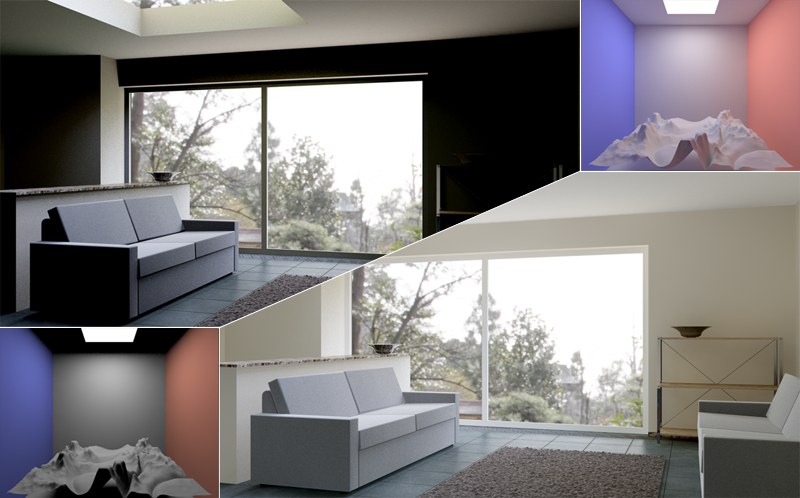Global Illumination
全局光源
The continual technological advances being made in the world of computer graphics (faster computers, improved algorithms, etc.) make realistic rendering increasingly easy. A major element of realistically rendered images is natural light dispersion within the scene. Two ways to achieve this are:
计算机图形学世界中不断进步的技术(更快的计算机、改进的算法等等)使得真实感渲染变得越来越容易。现实渲染图像的一个主要元素是场景中的自然光色散。实现这一目标的两种方法是:
- Very experienced 3D artists will place light sources in a precise manner that will result in realistic light dispersion. Advantage: Shorter render times. Disadvantage: You have to be very experienced to achieve acceptable results. 非常有经验的3D 艺术家将在一个精确的方式,将导致在现实的光分散光源。优点: 缩短渲染时间。缺点: 你必须非常有经验才能达到可接受的结果
- Light sources are placed at the exact locations at which they would be placed in the real world. Global Illumination (GI) is then applied to realistically disperse the light. Advantage: The dispersion of light corresponds to that in the real world, and even inexperienced artists can use this method. Disadvantage: Comparably long render times. 光源被放置在它们将被放置在现实世界中的确切位置。然后应用全局光源来真实地分散光线。优点: 光的色散相当于现实世界中的色散,即使是没有经验的艺术家也可以使用这种方法。缺点: 渲染时间相当长
那么,什么是 GI?
 Left: Scene rendered with Area Light, no GI. Right:
Scene rendered with GI. Notice the color bleeding - where the colored walls meet the back wall - and the
harmonious dispersion of light. The additional reflection of light makes a GI scene brighter overall and areas
that are completely black are very rare. (scene is © Holger Schömann) 左: 场景渲染区域灯光,没有 GI。右图: 用 GI 渲染的场景。请注意彩色出血——彩色的墙壁与后墙相接处——以及和谐的光散射。光线的额外反射使得 GI 场景整体更加明亮,而完全黑色的区域是非常罕见的。(场景是霍尔格 · 舍曼[ Holger Schömann ])
Left: Scene rendered with Area Light, no GI. Right:
Scene rendered with GI. Notice the color bleeding - where the colored walls meet the back wall - and the
harmonious dispersion of light. The additional reflection of light makes a GI scene brighter overall and areas
that are completely black are very rare. (scene is © Holger Schömann) 左: 场景渲染区域灯光,没有 GI。右图: 用 GI 渲染的场景。请注意彩色出血——彩色的墙壁与后墙相接处——以及和谐的光散射。光线的额外反射使得 GI 场景整体更加明亮,而完全黑色的区域是非常罕见的。(场景是霍尔格 · 舍曼[ Holger Schömann ])
GI is the interaction of light between different objects within a scene. Simply said, light is reflected onto objects, as it occurs in the real world. Light also reaches areas (e.g., corners) that normal light sources would not illuminate (in the example image above you can see many black areas that are not reached by any light source in the scene rendered without GI).
GI 是场景中不同物体之间光的相互作用。简单地说,光线被反射到物体上,就像它在现实世界中发生一样。光线也能到达普通光源不能照亮的区域(例如,角落)(在上面的例子中,你可以看到许多黑色区域,在没有 GI 的场景中,任何光源都无法到达这些区域)。
That’s pretty much what GI does. Although it sounds simple, the actual process is quite complicated: When a scene is rendered using conventional sources of light, light is only emitted from a limited number of light sources (the lights themselves). When GI is applied, pretty much any part of an object can reflect light.
这差不多就是美国大兵所做的。虽然这听起来很简单,但实际的过程却相当复杂: 当一个场景使用传统的光源渲染时,只有有限数量的光源(光源本身)发出光线。当应用 GI 时,物体的几乎任何部分都能反射光线。
Where can I find the GI settings?
在哪里可以找到 GI 设置?
GI parameters can be found in the following locations within Cinema 4D:
GI 参数可以在 Cinema 4D 的下列地点找到:
- Global: In the Render Settings: 全局: 在渲染设置中:Global Illumination 全局光源 And 还有Team-Render 团队-渲染
- At the material level in the Material Editor in the 在材质级别的材质编辑器中Illumination 照明 channel. 通道
- At the object level in the 中的对象级别Compositing 合成 tag. 标签
To activate GI all you have to do is:
要激活 GI,你需要做的就是:
-
Open the Edit Render Settings dialog window (main menu: 打开编辑渲染设置对话框窗口(主菜单:Render 渲染 - or simply
press Ctrl+B)
- 或者简单地按 Ctrl + b)
-
Click on the 点击Effects … 特效.. button and select 按钮并选择Global
Illumination 全局光源
-
In the GI settings that then appear, select the preset you need for your projection type from the 在随后出现的 GI 设置中,从Preset 预置 menu.
菜单
第一步
技巧和窍门
GI Portals and Polygon Lights: Function and Placement
GI 门户和多边形灯: 功能和布局
样本渲染
GI 设置